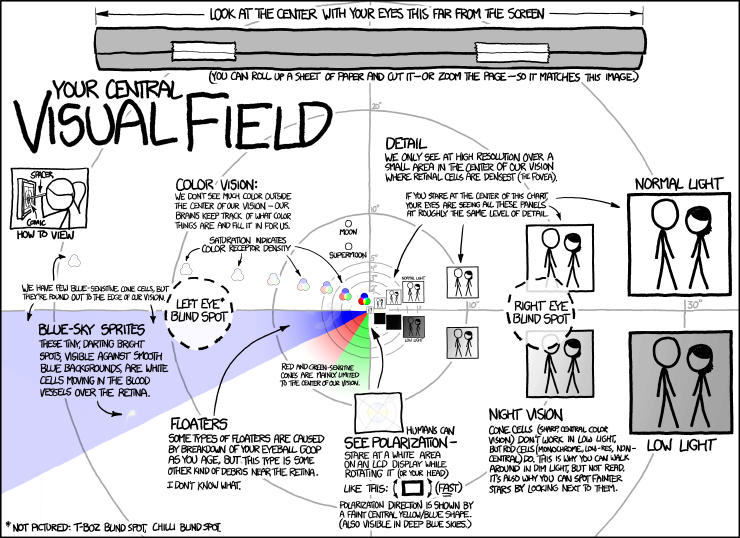A web comic of romance, sarcasm, math, and language.
New: what-if.xkcd.com
This week: How long would humans last in a robot apocalypse?
Scene: A chart is divided into four quadrants and seven concentric circles. The circles become more widely spaced as they get bigger and are labeled “2 degrees,” “3 degrees,” “4 degrees,” “5 degrees,” then jump to “10 degrees,” “20 degrees,” and “30 degrees.” At the top of the chart is a centered drawing of a rolled-up sheet of paper that equals about 55 total horizontal degrees of the chart. Above the drawing are instructions that read “Look at center with your eyes this far from the screen.” Arrows on either side of the print point at the ends of the drawing. Below the drawing, the instructions continue with “(you can roll up a piece of paper and cut it–or zoom the page–so it matches this image.)”
In the upper left quadrant, there are two very small circles, placed between the 5 and the 10 degree circles. The upper one is close to the 10 degree mark and is labeled “Moon.” The lower one is about halfway between the two degree markings and is labeled “Supermoon.”
A large title in the upper left of the quadrant reads “Your Central Visual Field.” Below the title, on the left, is a panel with a drawing labeled “How to View.” The drawing is a side view of a pony-tailed stick figure holding a rolled up piece of paper like a straw and using it to space the distance between her forehead and a view screen displaying this XKCD comic. In the center of the quadrant, a caption reads “Color Vision: We don’t see much color outside the center of our vision–our brains keep track of what color things are and fill it in for us.
Beneath this caption are several drawings of the Red-Green-Blue circles (three circles clumped together like a molecule) coming out in a line to the left from the center. As each drawing gets farther from the center, it has less and less color until, by the time they get to the 20 degree circle, they are almost completely colorless, except for a faint bit of blue in one circle. A caption with arrows pointing to the drawings reads “Saturation indicates color receptor density.”
The lower left quadrant is divided into three rays of blue, red, and green radiating from the center. The blue ray is at the top of the quadrant and goes all the way to to the edge, but the red and the green rays stop before they get to the 10 degree circle. A caption pointing to the blue ray and the faint blue circles in the quadrant above reads “We have few blue-sensitive cone cells, but they’re found out to the edge of our vision.”
Within the ray of blue is a white squiggly spot labeled “Blue-Sky Sprites: These tiny, darting bright spots, visible against smooth blue backgrounds, are white cells moving in the blood vessels over the retina.”
Near the center of the chart are larger, faintly gray squiggles labeled “Floaters: Some types of Floaters are caused by breakdown of your eyeball goop as you age, but this type is some other kind of debris near the retina I don’t know what.”
In the upper right quadrant, a caption reads
“Detail
We only see at high resolution over a small area in the center of our vision where retinal cells are densest (the Fovea).
If you stare at the center of this chart, your eyes are seeing all these panels at roughly the same level of detail.”
Beneath the caption, seven copies of the same panel, a drawing of two stick figures standing close together, radiate out to the right. The panels, labeled “Normal Light,” start out tiny at the center and double in size at approximately each degree marking.
The Lower Right Quadrant has the same repeated drawing radiating to the right, but with a much darker background and labeled “Low Light.” These panels look almost black at the center and lighten as they get farther out.
A caption in the center of this quadrant reads “Night Vision
Cone cells (sharp, central color vision) don’t work in low light, but red cells (monochrome, low-res, non-central) do. This is why you can walk around in dim light, but not read. It’s also why you can spot fainter stars by looking next to them.”
On the line between the lower left and right quadrants, there is an inset of the center of the quadrants, captioned “Humans can see polarization–stare at a white area on an LCD display while rotating it (or your head) like this : (drawing of a LCD screen with double-headed arrows on either side pointing up and down)(fast). Polarization direction is shown by a faint central yellow/blue shape. (Also visible in deep blue skies.)
On the line between the upper and lower quadrants, midway between the center and the outer edges, are two dotted circles, one on the left and one on the right. The right one is labeled “Right Eye Blind Spot.” The left one is labeled “Left Eye Blind Spot” with an asterisk. At the bottom of the lower left quadrant is the asterisk referece which reads “Not Pictured: T-Boz Blind Spot, Chilli Blind Spot.”
Hover text: I recently learned something that solved a mystery that had bugged me since childhood–why, when I looked at an analog clock, the hand would sometimes seem to take a couple seconds to start ticking. Google “stopped clock illusion.”
Warning: This comic occasionally contains strong language (which may be unsuitable for children), unusual humor (which may be unsuitable for adults), and advanced mathematics (which may be unsuitable for liberal-arts majors).


Follow us on Twitter, Like us on Facebook